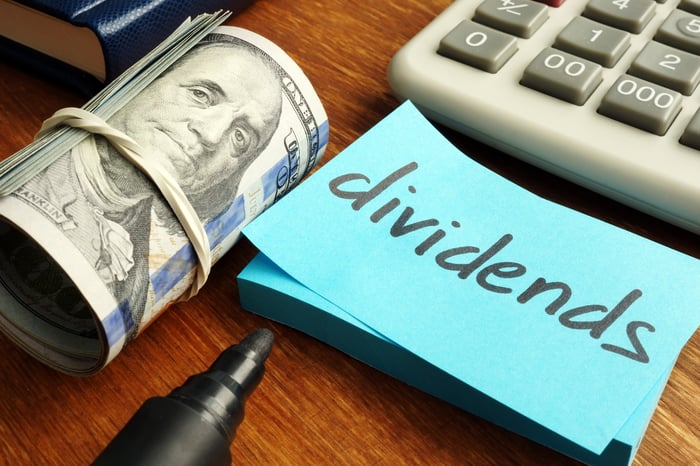This Energy Stock Plans to Maintain Its 10%-Yielding Dividend
ONEOK believes it can navigate through the oil industry's current rough patch while leaving its dividend intact.
by Matthew DiLallo (TMFmd19)Shares of ONEOK (NYSE:OKE) have been extremely volatile this year. Due to all the turbulence in the oil market, the pipeline company's stock plummeted almost 80% at one point. While its shares have recovered some of their lost ground, they're still down about 50%.
That massive sell-off has pushed up the yield on ONEOK's dividend over 10%. When a payout reaches that high, it's usually because the market doesn't believe it's sustainable for much longer.
However, ONEOK thinks the market has it all wrong. Here's why it doesn't accept the view that its payout will become another casualty of the oil industry's currently challenging times.

What's driving the dividend concerns
One of the main fuel sources for ONEOK's dividend is its extensive midstream operations in North Dakota's Bakken shale region. The company is one of the largest producers of natural gas, which oil companies produce in association with crude. It also operates major pipelines shipping natural gas and natural gas liquids (NGLs) from the region to market centers.
Unfortunately, crashing crude oil prices have walloped the higher-cost Bakken area. One leading producer, Whiting Petroleum, filed for bankruptcy. Another top operator, Continental Resources, had to shut in nearly its entire production base in the region because its wells weren't profitable. Others also have shut in wells and stopped drilling new ones because of weak market conditions.
As a result, the region's output has tumbled, which is impacting the volumes flowing through ONEOK's midstream systems. Because of that, the company won't generate as much fee-based income as initially anticipated. That's why "investors have started to raise questions around the dividend, [which] could persist until we see a rebound from the shut-ins in the Bakken," according to comments by an analyst at UBS. Analysts at J.P. Morgan also believe "ONEOK's dividend could be pressured" unless there's an "appreciable pickup" in the utilization of the company's assets next year, given the company's relatively high debt level.
Making moves to preserve the payout
While investors and analysts question the sustainability of ONEOK's payout, the company believes it can maintain it during this rough patch. On the company's recent first-quarter conference call, CEO Terry Spencer stated:
As we look to the future, we expect our business to generate sufficient cash flow to pay the dividend. Our decision to significantly reduce capital spending until growth opportunities return puts us in a good position to continue returning value to our shareholders. As we always do, each quarter we'll work with our Board to assess our forward views of future cash flows and the dividend as appropriate. We've been through cycles before and we have a long track record of delivering on expected results. And most importantly, the fundamentals of our business have not changed. Our strong balance sheet and liquidity provide important financial flexibility.
As the CEO notes, ONEOK currently generates more than enough money to cover its dividend. Last quarter, for example, it produced $136 million in excess cash after paying its dividend, which was 24% above its level at the end of 2019.
However, the concern lies in the fact that ONEOK spent $900 million on capital projects during the first quarter. Because of that, it outspent cash flow, causing its leverage ratio to rise to 4.86 times debt-to-EBITDA, which was well above is sub-four times target. With the company expecting to invest a total of $1.4 billion to $1.8 billion this year, leverage will likely keep rising.
On a more positive note, ONEOK hasn't had any trouble accessing credit to cover the shortfall between excess cash and capital spending thanks to its investment-grade balance sheet. In March, the company issued $1.75 billion in debt ($400 million of 2.2% five-year notes, $850 million of 3.1% 10-year notes, and $500 million of 4.5% 30-year notes), which enabled it to refinance existing debt while leaving it with $600 million of cash to fund capital expenses. It also completed a $1.5 billion debt offering in May ($600 million of 5.58% five-year notes, $600 million of 6.35% 10-year notes, and $300 million of 7.15% 30-year notes). While it will pay a higher interest rate on this new debt, the issuance showed that ONEOK could borrow money to finance its capital program. With a cash-rich balance sheet and another $2.5 billion of available borrowing capacity on its credit facility, ONEOK believes it has the financial flexibility to navigate through the turbulent market conditions without adjusting its dividend.
A high-risk, high-reward dividend
ONEOK's dividend appears sustainable for the time being since it had no problem raising capital to fund its expansion program. However, that doesn't automatically guarantee the safety of its dividend. If market conditions don't improve later this year, ONEOK might start feeling some pressure to shore up its balance sheet. That could force the company to reduce its payout and use that cash to pay off debt. Because of that, dividend investors should use caution when considering ONEOK's monster payout.